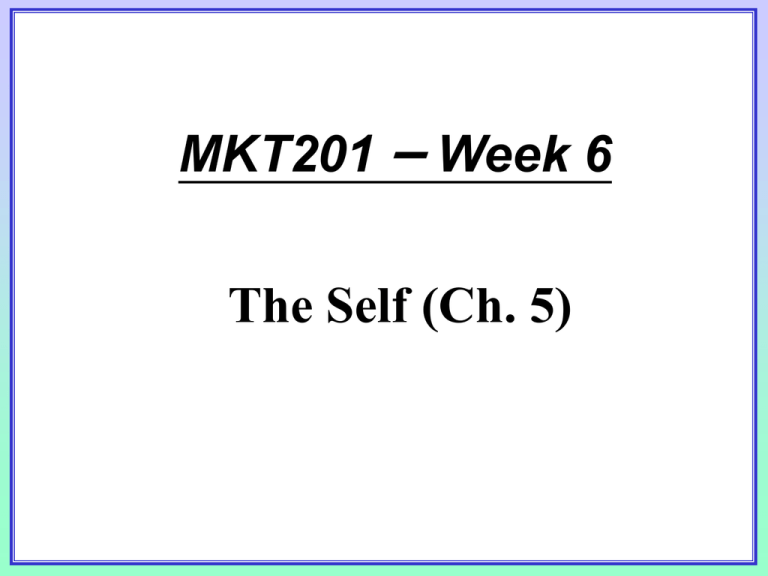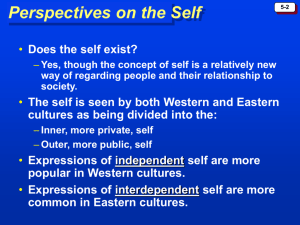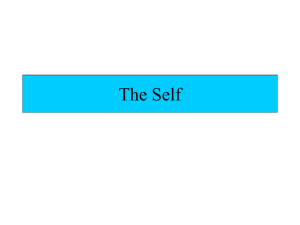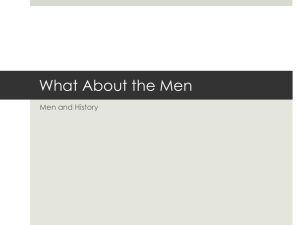
MKT201 – Week 6
The Self (Ch. 5)
Perspectives on the Self
• Does the Self Exist?
– 1980’s called the “Me Decade”
– March 7th designated “Self Day” by Self
magazine
– Western societies emphasize uniqueness of
self.
– Collective self: Eastern culture’s belief that
a person’s identity is derived from his or her
social group.
– Mien-Tzu (FACE): Confucian belief that
reputation is achieved through success and
ostentation (boastful display)
Self Concept
• Self Concept:
– The beliefs a person holds about his or her own attributes
and how he or she evaluates these qualities
• Many Dimensions of the Attributes of Self Concept such
as:
– Content (facial attractiveness Vs mental aptitude)
– Positivity (i.e. self-esteem)
– Intensity & stability over time
– Accuracy (i.e. the degree to which one’s self-assessment
corresponds to reality)
• Consumer perceptions of self can be quite distorted,
particularly with regard to their physical appearance.
Self-Esteem
Self-esteem:
– Refers to the positivity of a person’s self-concept.
• Marketing communication attempts to influence
consumer by:
• Social Comparison:
– A process by which consumers evaluate themselves
by comparing themselves with others (particularly
comparisons with idealized images of people in
advertising)
• Self-esteem Advertising:
– Attempts to change product attitudes by stimulating
positive feelings about the self.
Real and Idealized Selves
• Ideal Self:
– A person’s conception of how he or she would like to be
– Partially molded by elements of a consumer’s culture
• Actual Self:
– A person’s realistic appraisal of the qualities he or she does
and does not possess
Fantasy: Bridging the Gap between the Selves:
– Fantasy: A self-induced shift in consciousness
– Fantasy appeals: Marketing communications aimed at
individuals with a large discrepancy between their real and
ideal selves
Self-Concept
Components of the Self-Concept
Content, Positivity or Negativity, Intensity,
Stability Over Time, and Accuracy
Self-Esteem
Refers to the Positivity of a Person’s Self-Concept
Real and Ideal Selves
Ideal - How a Person Would Like to Be
Real - Realistic Appraisal of Who We Really Are
Fantasy: Bridging the Gap Between the Selves
When the Gap Between the Real and Ideal Self is Large,
Those Consumers are Good Targets for Fantasy Appeals
Fantasy Appeals
Multiple Selves
• Role Identities:
– Different components of the self (student / dancer;
active at any given time)
• Symbolic Interactionism:
– Stresses that relationships with other people play a
large part in forming the self (symbols -> meanings:
red light: stop; gold watch: rich man)
– Self-fulfilling prophecy (prediction): By acting the
way we assume others expect us to act, we wind up
confirming these perceptions (e.g. boy – playing toy
guns)
• The Looking-Glass Self:
– The process of imagining the reactions of others
toward us, i.e., “taking the role of the other”;
depending on whose views we’re considering.
Self-Consciousness
• Self-Consciousness:
– A painful awareness of oneself magnified by
the belief that others are intently watching.
– Excessively conscious of one's appearance
or manner (think about Michael Jackson)
Self-Consciousness (cont’d)
Techniques to measure such tendency:
– Measurement of Public Self-Consciousness :
• A heightened concern about the nature of one’s
public “image”
• Results in more concern about the appropriateness
of products and consumption activities (e.g.,
clothing, cosmetics)
– Measurement of Self Monitoring:
• Awareness of how one presents oneself in a social
environment (e.g., physical appearance,
accomplishments)
Consumption and Self-Concept
Identity Marketing:
- a strategy which tries to alter some aspects
of a person’s self to advertise for a branded
product.
e.g., free season tickets for life for anyone
who will tattoo the logo of a product/brand.
Consumption and Self-Concept
• Products that Shape the Self: You are What you
Consume
– People use an individual’s consumption behaviors to
help them make judgments about that person’s social
identity.
– Symbolic self-completion theory: People who have
an incomplete self-definition tend to complete this
identity by acquiring and displaying symbols associated
with it.
Example: Adolescent boys (age 13-17)
– using “macho” products such as cars and cigarettes
(showing masculinity)
Consumption and Self-Concept
• Self/Product Congruence:
– Consumers demonstrate consistency between their
values and the things they buy.
– Self-image congruence models: Products will be chosen
when their attributes match some aspect of the self.
– predict that products will be chosen when their
attributes match some aspect of the self.
• Ideal-self : more relevant for highly expressive social
products.
• Actual-self: more relevant for everyday, functional
products.
The Extended Self
• Extended Self:
– External objects that consumers consider a part of
themselves
• Four Levels of the Extended Self:
–
–
–
–
(1) Individual Level: Personal possessions
(2) Family Level: Residence and furnishings
(3) Community Level: Neighborhood or town one is from
(4) Group Level: Social groups
• A consumer may also feel that landmarks,
monuments, or sports teams are part of the extended
self.
• Identity Theft:
– Criminal use of personal information to secure credit
Protection Against Identity Theft
The Extended Self
Those External Objects That We Consider a Part of
Us Comprise the Extended Self.
There Are Four Levels of the Extended Self:
Individual Level
Personal Possessions (you are what you wear)
Family Level
Residence and Furnishings (symbolic body)
Community Level
Neighborhood or Town (belonging)
Group Level
Social Groups (subcultures)
Advertisements: Extending the Self
• This Italian ad
demonstrates that our
favorite products are part
of the extended self.
Discussion Question
• Some consumers feel that a sports team is part of the extended
self. At www.flameheads.com they celebrate fanaticism
toward the Tennessee Titans football team.
• How does affiliation with a sports team affect self
perceptions? What other affiliations are part of the extended
self?
Sex Roles
• Sex Identity:
– An important component of a consumer’s self
concept
• Gender Differences in Socialization:
– Agentic goals (Males): Stress self assertion and
mastery
– Communal goals (Females): Stress affiliation and
fostering of harmonious relations
Sex Roles
• Gender differences in
consumption
situations
– E.g., food preferences
of men vs. women
Satirical (Sarcastic) Ad of Exploitation
• This French shoe ad
pokes fun at ads that
demean women by
proclaiming: “No
woman’s body was
exploited in the making
of this advertisement.”
Sex Roles (cont.)
• Gender Versus Sexual Identity:
– Sex-Typed Traits: Characteristics stereotypically
associated with gender (masculinity Vs femininity)
– Sex-Typed Products:
• Many products are sex-typed (i.e., they take on masculine or
feminine attributes and are associated with gender. (Beer:
masculine, Shampoo: feminine)
• Androgyny:
– Refers to the possession of both masculine and feminine
traits
– Sex-typed people: Stereotypically masculine or feminine
– Androgynous people: Mixed gender characteristics
Gender vs. Sexual Identity
• Many products are sextyped…
– They take on masculine
& feminine attributes
• Princess telephones
• Thor’s Hammer vodka
Culturally Bound Sex Roles
• This ad for Bijan illustrates how sex-role identities are
culturally bound by contrasting the expectations of how
women should appear in two different countries. (Perfumes)
Sex Roles (cont.)
• Female Sex Roles:
– Female sex roles are still evolving
• Male Sex Roles:
– Masculinism: The study of the male image and the
cultural meanings of masculinity
• Gay, Lesbian, Bisexual, and Transgender (GLBT)
Consumers:
– GLBT population is an attractive segment to marketers
– The 1990’s saw big corporations actively court this market
segment
Female Sex Roles (S5)
• New managerial class
of women
– Has forced marketers
to reexamine
strategies
• Sporting goods, car
accessories, and
electronics products for
women
Male Sex Roles
• Masculinism
http://en.wikipedia.org/wiki/Masculinity
– Three models of masculinity:
• Breadwinner (civic virtues, pursuit material
success)
• Rebel (rebellion, independence, adventure,
potency/powerful)
• Man-of-action hero (best of the other two
models)
• Misandry (hatred of males as a sex )
http://en.wikipedia.org/wiki/Misandry
Male Sex Roles (Cont’d)
• Grooming products for men
– Metrosexual (straight, urban male who exhibits
strong interests and knowledge about fashion, home
design, gourmet cooking and personal care)
• David Beckham
• Queer Eye for the Straight Guy
http://en.wikipedia.org/wiki/Queer_Eye_for_the_Straight_
Guy
– Prosumers/urban influentials (educated customers
focus on personal appearance and living
environment)
Discussion
• The “metrosexual” is a big
buzzword in marketing,
but is it real or just media
hype?
• Do you see men in your age
group changing their ideas
about acceptable interests
for males (e.g., home
design, cooking, etc.)?
• http://en.wikipedia.org/wiki/Metrosex
ual
Sex Roles
Gender Differences in Socialization
Males:
Agentic Goals Such as
Self-Assertion, Mastery
Females:
Communal Goals Such As
Affiliation, Relationships
Gender Versus Sexual Identity
Sex-Typed Traits
Sex-Typed Products
Androgyny
Roles
GLBT Consumers
(Gay, Lesbian, Bisexual, and Transgender)
• ~4%-8% of U.S.
population
– Equivalent to Asian
American market
– Spends $250-$350 billion a
year
– Simmons study: compared
to heterosexual markets,
readers of gay publications
are more likely to…
• Hold professional jobs
• Own a vacation home
• Own a notebook computer
Body Image
• Body Image:
– Refers to a consumer’s subjective evaluation of
his or her physical self
• Body Cathexis:
– A person’s feelings
about his or her body
• Ideal of Beauty:
– A particular model, or exemplar, of appearance
Ideals of Beauty
• Is Beauty Universal?
– Men are attracted to an hourglass shape
– Women prefer men with a heavy lower face, aboveaverage height, and a prominent brow
• The Western Ideal:
– Big round eyes, tiny waists, large breasts, blond hair, and
blue eyes
• Ideals of Beauty over Time:
– Periods of history tend to be characterized by a specific
“look”
– Sexual dimorphic markers: Aspects of the body that
distinguish between the sexes
Ideals of Beauty Over Time
• Specific “looks”/ideals of beauty
– Early 1800s: delicate/”looking ill” appearance,
18-inch waistline (use of corsets)
– 1890s: voluptuous, lusty woman
– Bad economy: mature features vs. good
economy: babyish features
– 1990s: “waif” look (large round eyes and a very
thin body) http://en.wikipedia.org/wiki/Waif
– Modern women: high heels, body waxing,
eyelifts, liposuction
Waist-Hip Ratios
(normal: 0.6 – 0.8)
Beauty Ideals in the 1950’s
• This 1951 bathing beauty exemplified an ideal of American
femininity at that time.
Ideals of Beauty Over Time
(Cont’d)
• Media & marketing
communicate
standards of beauty
– Barbie dolls:
unnatural ideal of
thinness
• Plus-sized apparel
market
• Strongly masculine,
muscled body for
men
Working on the Body
• Fattism:
– Our society is obsessed with weight
• Body Image Distortions:
– Women’s ideal figure is much thinner than their actual
figure
– Anorexia: Starving oneself in a quest for thinness
– Bulimia: Binge (uncontrolled) eating followed by purging
(vomiting, laxatives, fasting, or over-exercising)
– Body dysmorphic disorder: An obsession with perceived
flaws in appearance
Unrealistic Body Shape Expectations
• This ad for an online
weight-loss site drives
home the idea that the
media often communicate
unrealistic expectations
about body shape.
Discussion Question
• In this advertisement, it is
insinuated/introduced that
this model’s physique was
achieved partially through
drinking milk. (Notice that
the model is so thin you can
see her ribs.)
• Is her physique really ideal?
What kind of distorted
message is this sending to
young girls about body
image?
Distorted Body Image
Cultural Emphasis on Thinness
• Society’s emphasis on thinness makes many consumers
insecure about their body image. This South American ad
promises, “You’ll never have to go to the beach in a T-Shirt
again.”
Working on the Body (cont.)
• Cosmetic Surgery:
– Consumers are increasing electing to have cosmetic
surgery to change a poor body image or enhance
appearance.
– Men are increasingly having cosmetic surgery too.
• Breast Augmentation:
– Our culture tends to equate breast size with sex appeal.
– Some women have breast augmentation procedures
because they feel larger breasts will increase their
allure/attractiveness.
Body Decoration & Mutilation
• Decorating the self…
– Separates group members
from nonmembers
– Places the individual in the
social organization
– Provides a sense of security
• Tattoos & body piercing
– Historically associated with
social outcasts
– Now a fashion statement
Body Decoration and Mutilation: Purposes
Separate Group Members From Nonmembers
Place the Individual in the Social Organization
(e.g. boy-> man)
Place the Person in a Gender Category (e.g. red lips)
Enhance Sex-Role Identification (e.g. high-heel shoes)
Indicate Desired Social Conduct (e.g. earring for gays)
Indicate High Status or Rank (e.g. glasses with clear lenses)
Provide a Sense of Security (e.g. lucky ornaments)
Tattooing
• Tattooing is becoming
mainstream. This
Spanish ad for Nike
tennis products says,
“Rest in heaven, not on
the court.”
Body Piercing
• Body piercing has
practically become a
mainstream fashion
statement.








